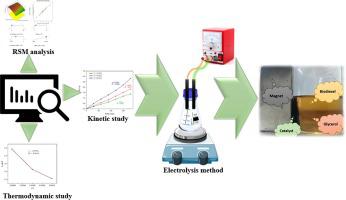Energy Conversion and Management ( IF 9.9 ) Pub Date : 2021-10-06 , DOI: 10.1016/j.enconman.2021.114807 Maryam Helmi 1 , Alireza Hemmati 2

|
In this research, biodiesel was produced from waste cooking oil (WCO) via a magnetically and biodegradable heterogeneous base catalyst of NaOH/Chitosan-Fe3O4. The catalyst was characterized using X-ray powder diffraction (XRD), Field Emission Scanning Electron Microscopy (FESEM), Energy Dispersive X-Ray (EDX), EDX-mapping, Vibrating-Sample Magnetometer (VSM), Brunauer-Emmett-Teller (BET), Transmission Electron Microscopy (TEM), and Fourier-transform infrared spectroscopy (FTIR) analyses. The catalyst performance was also studied in the transesterification reaction of WCO conversion to biodiesel. The process was optimized via the central composite design (CCD) through the response surface methodology (RSM) method. The influences of major factors, including methanol to oil molar ratio (6:1–12:1), catalyst weight (0.25–1 wt%), and time (4–8 h), were examined on the reaction behavior. The maximum FAME yield was 92% under the following optimal conditions: 0.5 wt% NaOH/Chitosan-Fe3O4 catalyst, methanol to oil ratio of 6:1, reaction time of 4.5 h, and temperature of 25 °C. The Gas Chromatography–Mass Spectrometry (GC–MS) and Inductively Coupled Plasma- Optical Emission Spectroscopy (ICP-OES) were used to determine the fatty acid profile and metal contents of samples, respectively. Based on the physicochemical properties, it was concluded that the produced biodiesel had the same properties as conventional petro-diesel. Further, a kinetic study revealed that the electrolysis method was a situ-transesterification reaction with a pseudo-first-order kinetics and activation energy of 21 kJ/mol. From the thermodynamic calculations, the values of ΔS, ΔΗ, and ΔG were found to be −0.23 kJ/mol K, 18.20 kJ/mol, and 95.13 kJ/mol, respectively.
中文翻译:

NaOH/壳聚糖-Fe3O4 磁性固体碱催化剂的合成,用于从废食用油生产生物柴油:优化、动力学和热力学研究
在这项研究中,通过 NaOH/壳聚糖-Fe 3 O 4磁性和可生物降解的非均相碱催化剂,从废食用油 (WCO) 中生产生物柴油. 使用 X 射线粉末衍射 (XRD)、场发射扫描电子显微镜 (FESEM)、能量色散 X 射线 (EDX)、EDX-mapping、振动样品磁强计 (VSM)、Brunauer-Emmett-Teller ( BET)、透射电子显微镜 (TEM) 和傅立叶变换红外光谱 (FTIR) 分析。还研究了在 WCO 转化为生物柴油的酯交换反应中的催化剂性能。该过程通过响应面方法 (RSM) 方法通过中心复合设计 (CCD) 进行优化。检查了主要因素对反应行为的影响,包括甲醇与油的摩尔比(6:1–12:1)、催化剂重量(0.25–1 wt%)和时间(4–8 h)。在以下最佳条件下,最大 FAME 产率为 92%:0.5 wt% NaOH/壳聚糖-Fe 3O 4催化剂,甲醇油比6:1,反应时间4.5小时,温度25℃。气相色谱-质谱 (GC-MS) 和电感耦合等离子体发射光谱 (ICP-OES) 分别用于测定样品的脂肪酸谱和金属含量。根据理化性质,得出的结论是生产的生物柴油具有与常规石油柴油相同的性质。此外,动力学研究表明,电解方法是一种原位酯交换反应,具有拟一级动力学和 21 kJ/mol 的活化能。根据热力学计算,发现ΔS、ΔH和ΔG的值分别为-0.23 kJ/mol K、18.20 kJ/mol和95.13 kJ/mol。









































 京公网安备 11010802027423号
京公网安备 11010802027423号